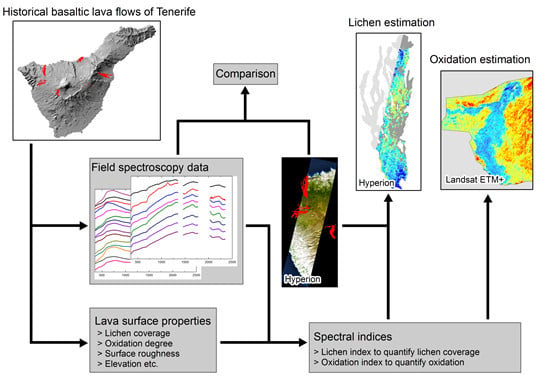Impact of Environmental Factors on the Spectral Characteristics of Lava Surfaces: Field Spectrometry of Basaltic Lava Flows on Tenerife, Canary Islands, Spain
Abstract
:1. Introduction
2. Study Area
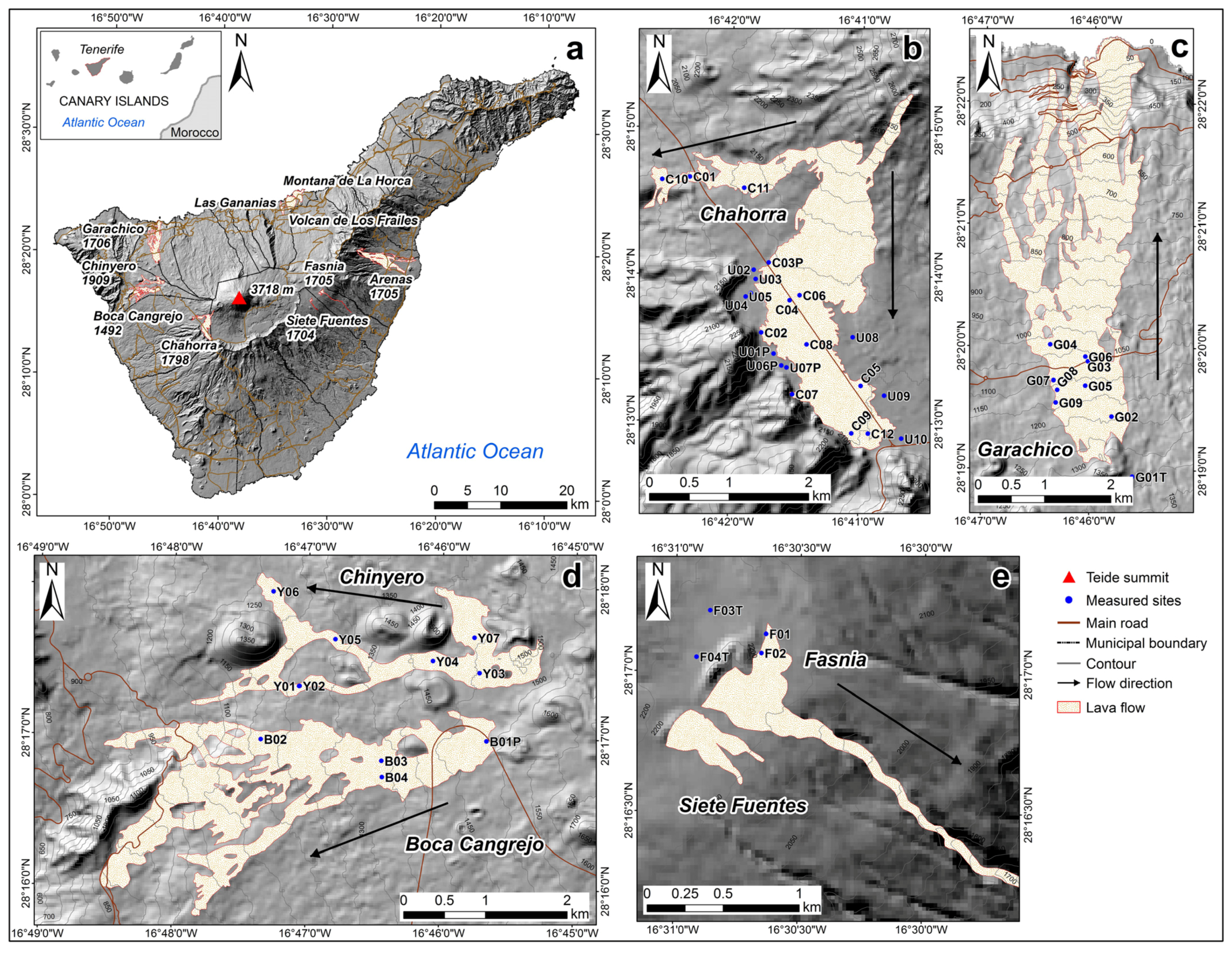
3. Methodology
3.1. Field Spectral Measurements
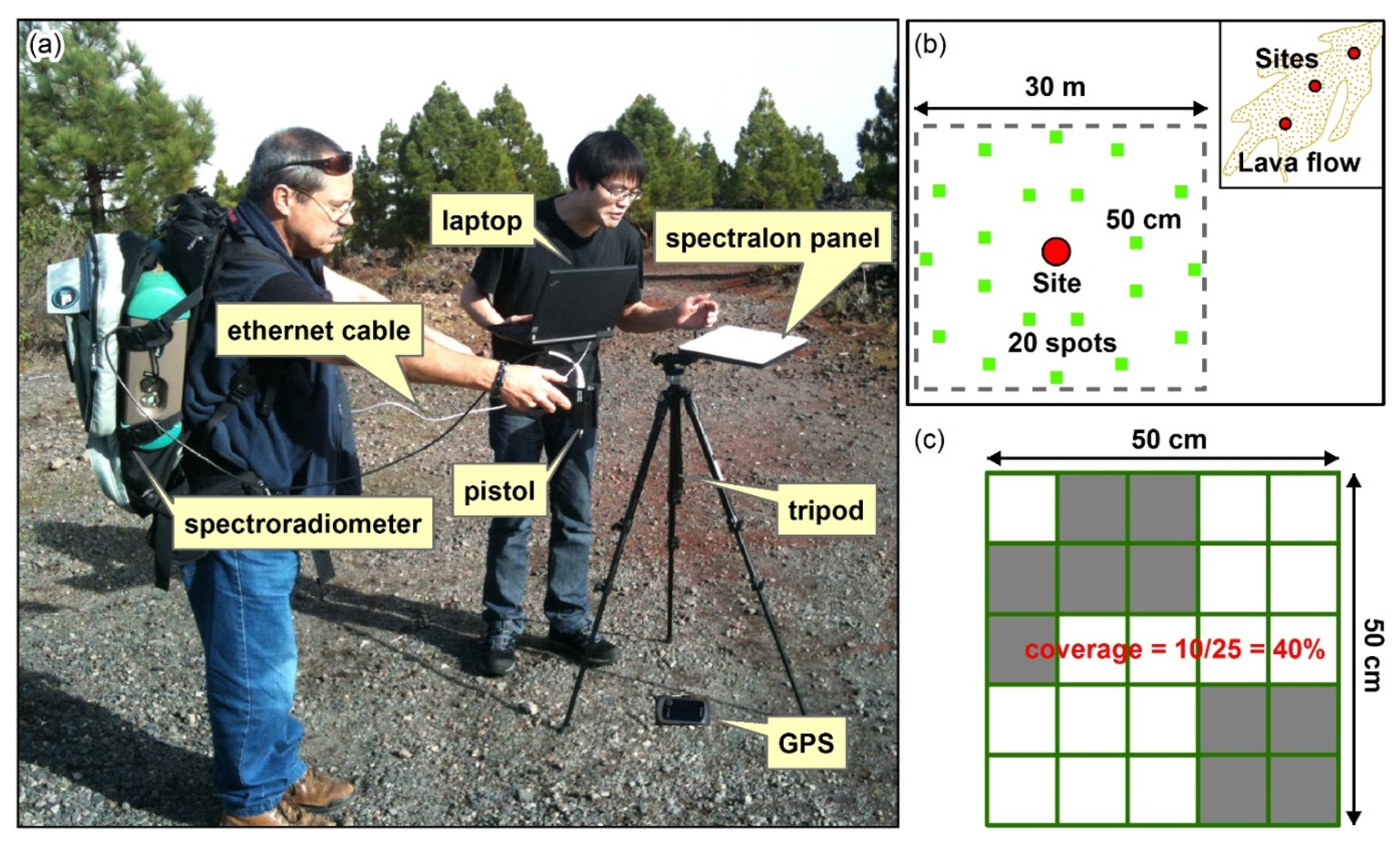
3.2. Quantification of Weathering
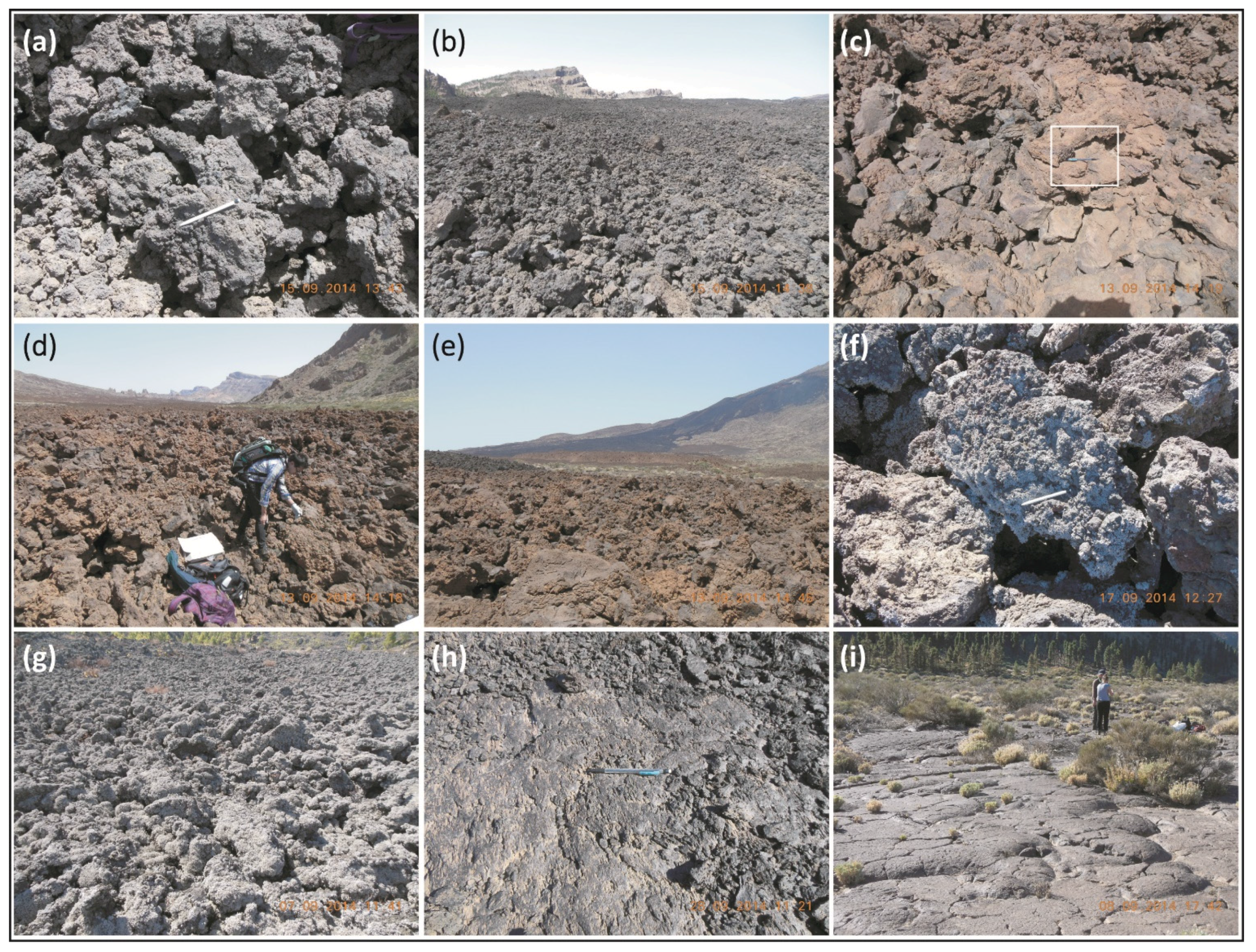
3.3. Surface Roughness
3.4. Processing of Field Spectra
3.5. Spectral Indices
3.6. Satellite Remote Sensing Data
4. Results
4.1. Spectral Reflectance of Volcanic Surfaces
4.1.1. Lava Flows
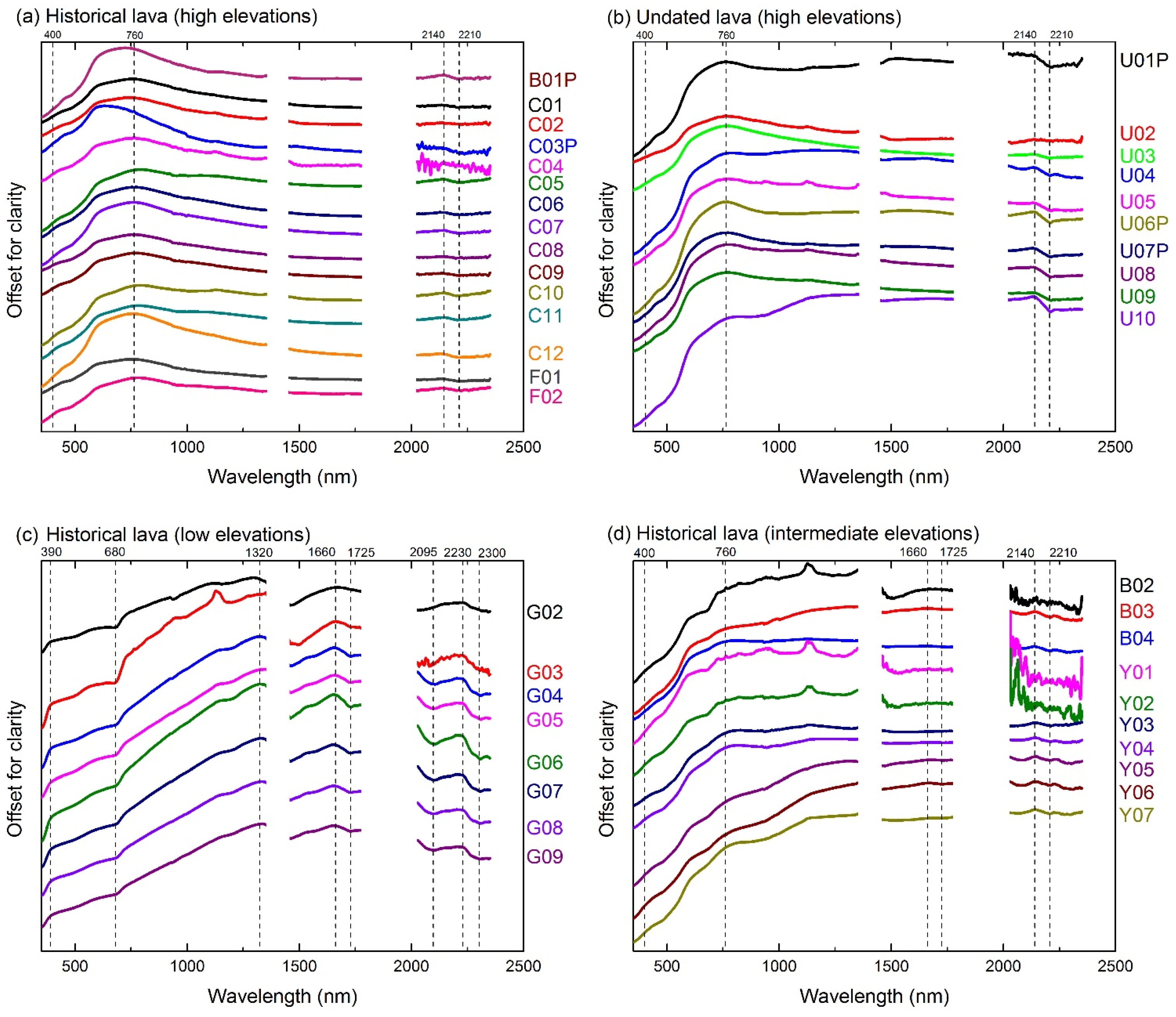
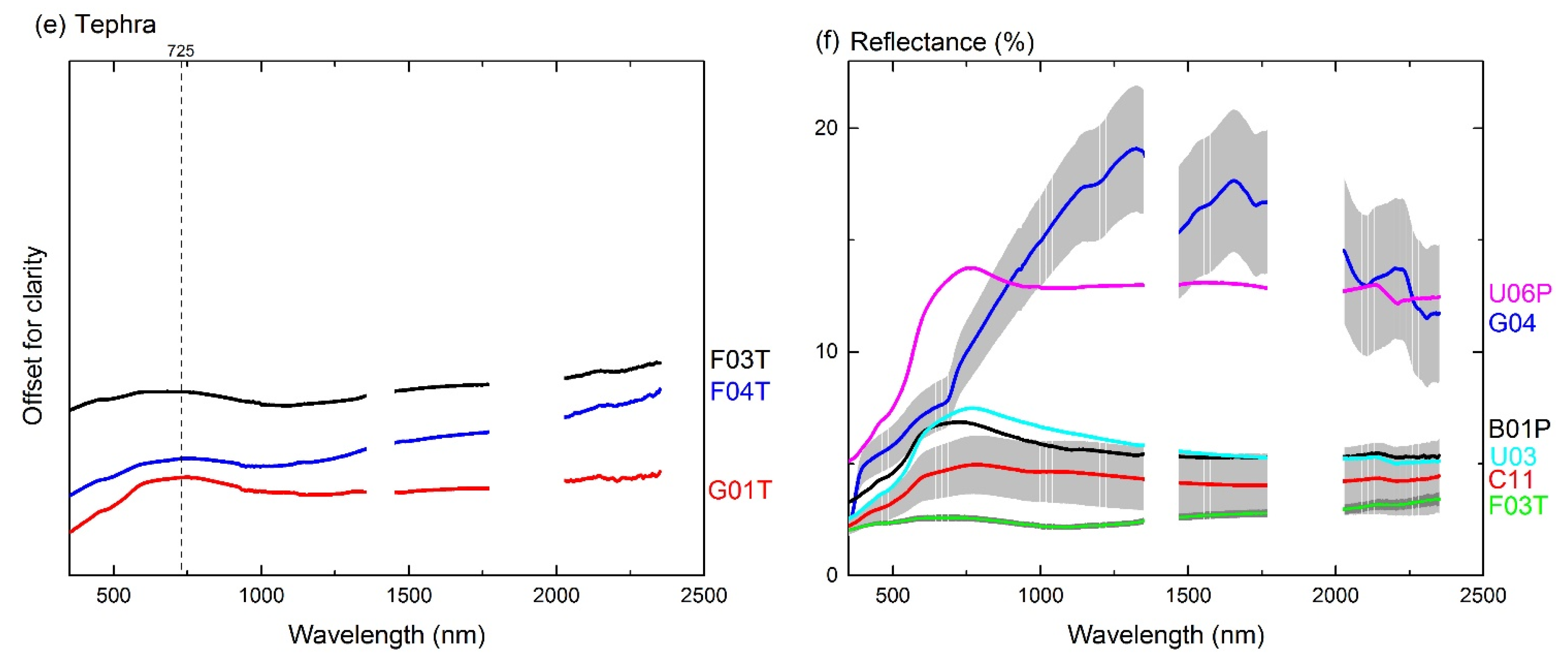
4.1.2. Tephra
4.2. Comparison with Hyperspectral Image Data

4.3. Effect of Weathering
4.3.1. Oxidation
- The slopes of the reflectance curves between 400 and ~800 nm have been reported to show a systematic increase with the relative ages of lava flows as well as the ferric iron content [15].
- The ratio of the Landsat red band to blue band has been reported as useful for measuring the red coloration of rocks [56]. We therefore considered the wavelength ranges 450–520 nm and 630–690 nm, corresponding to Landsat band 1 (blue) and band 3 (red), respectively. The central wavelengths (485 nm and 660 nm) of the two ranges were also tested.
- We also considered the 450–495 nm and 620–750 nm ranges, corresponding to the entire blue and red ranges of the electromagnetic spectrum, respectively, as well as their central wavelengths (475 nm and 680 nm).
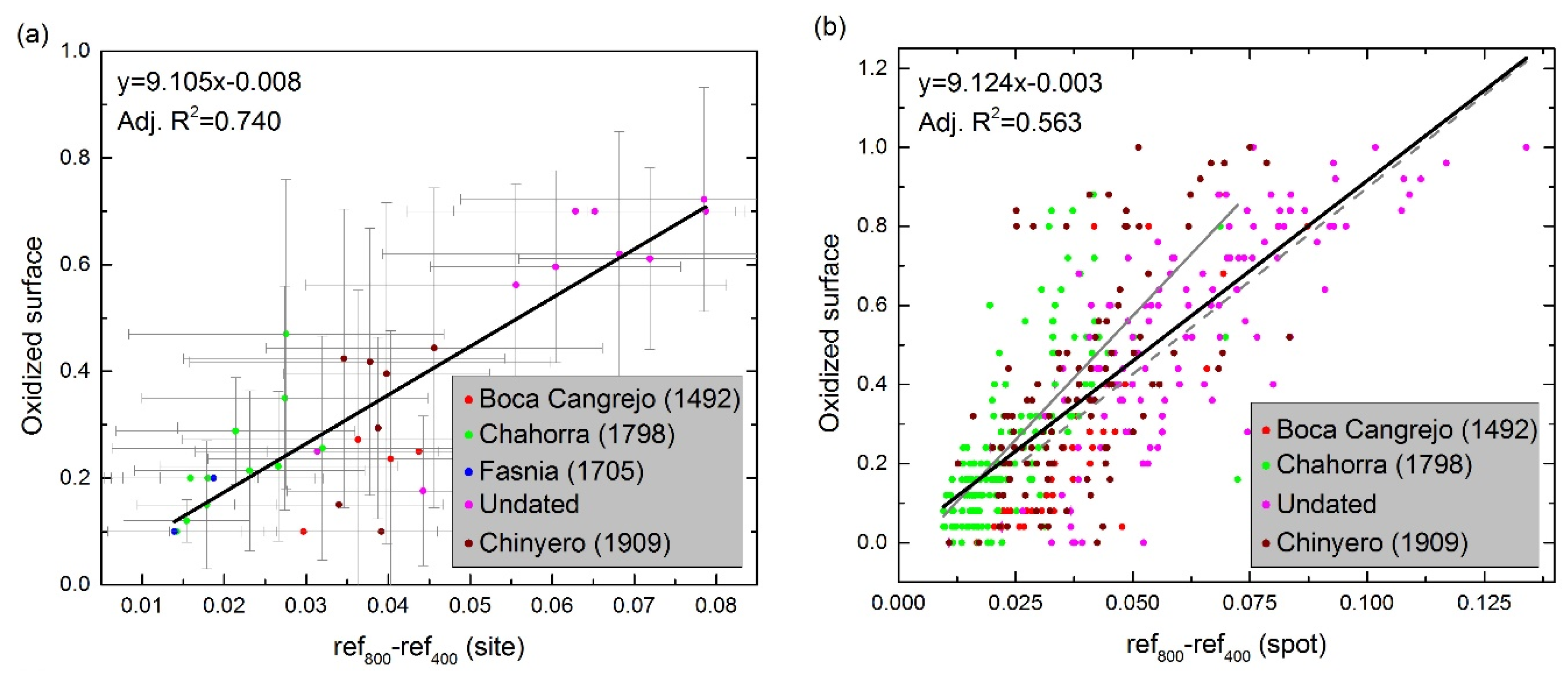
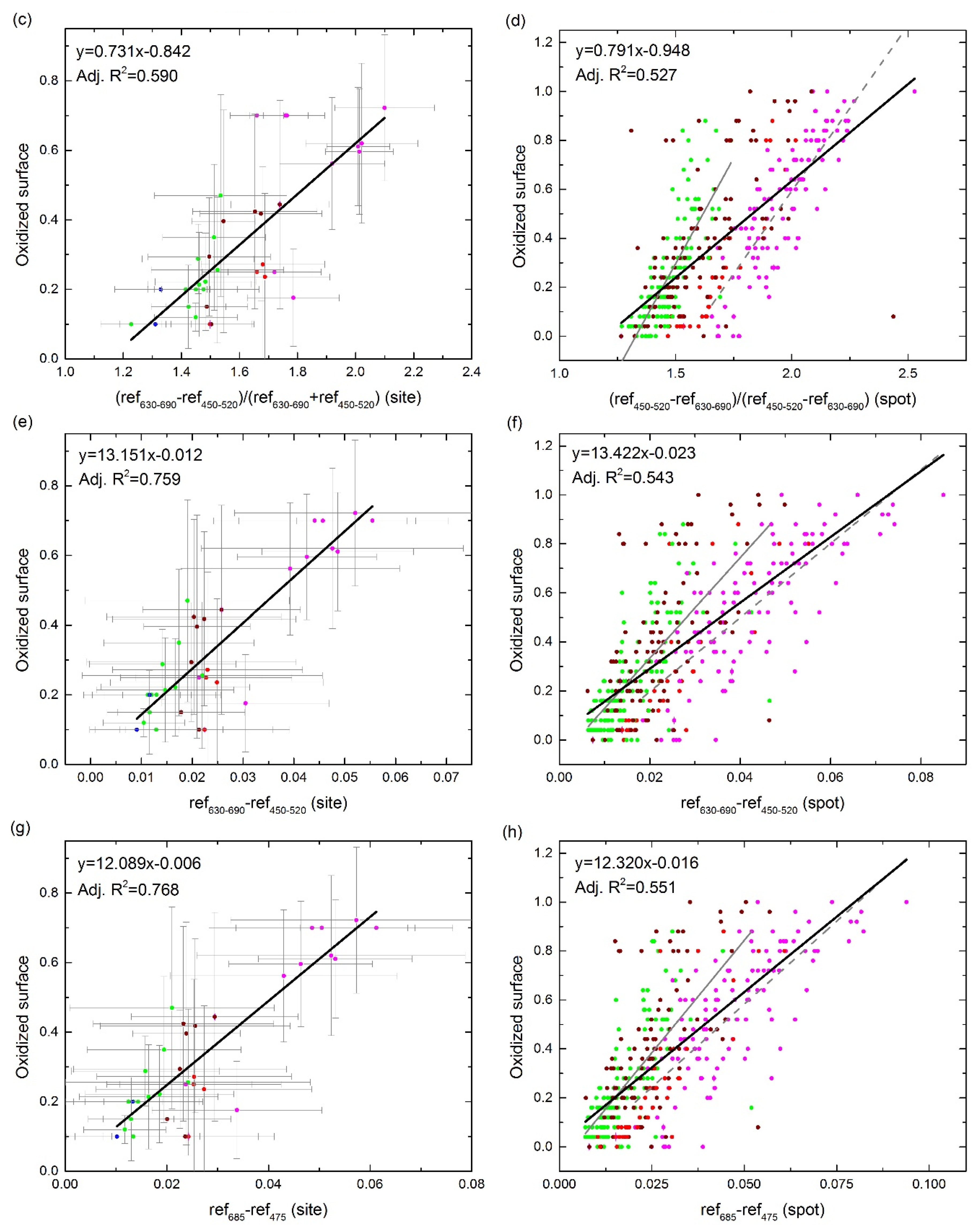
4.3.2. Lichen Cover
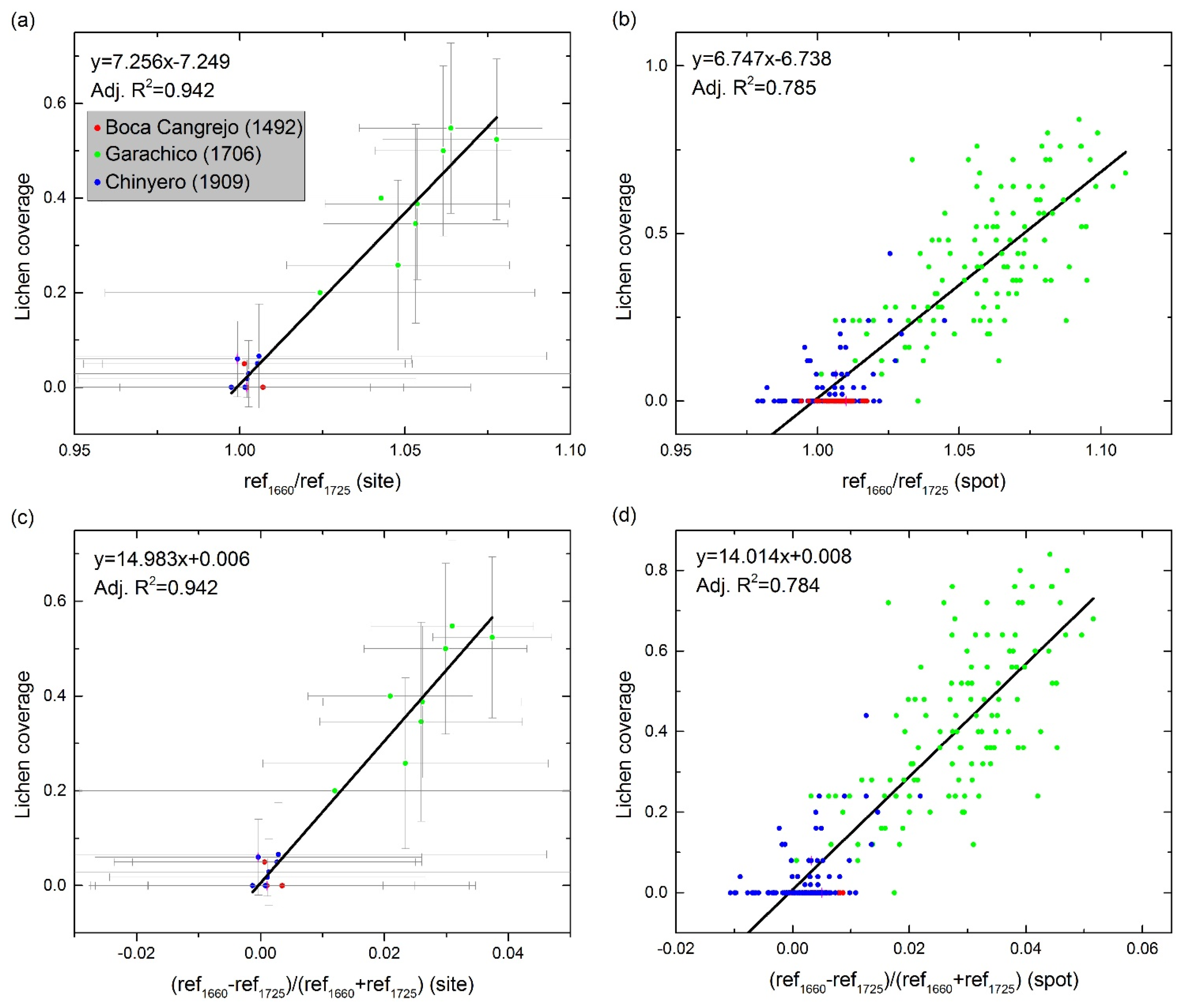
4.4. Effect of Surface Roughness
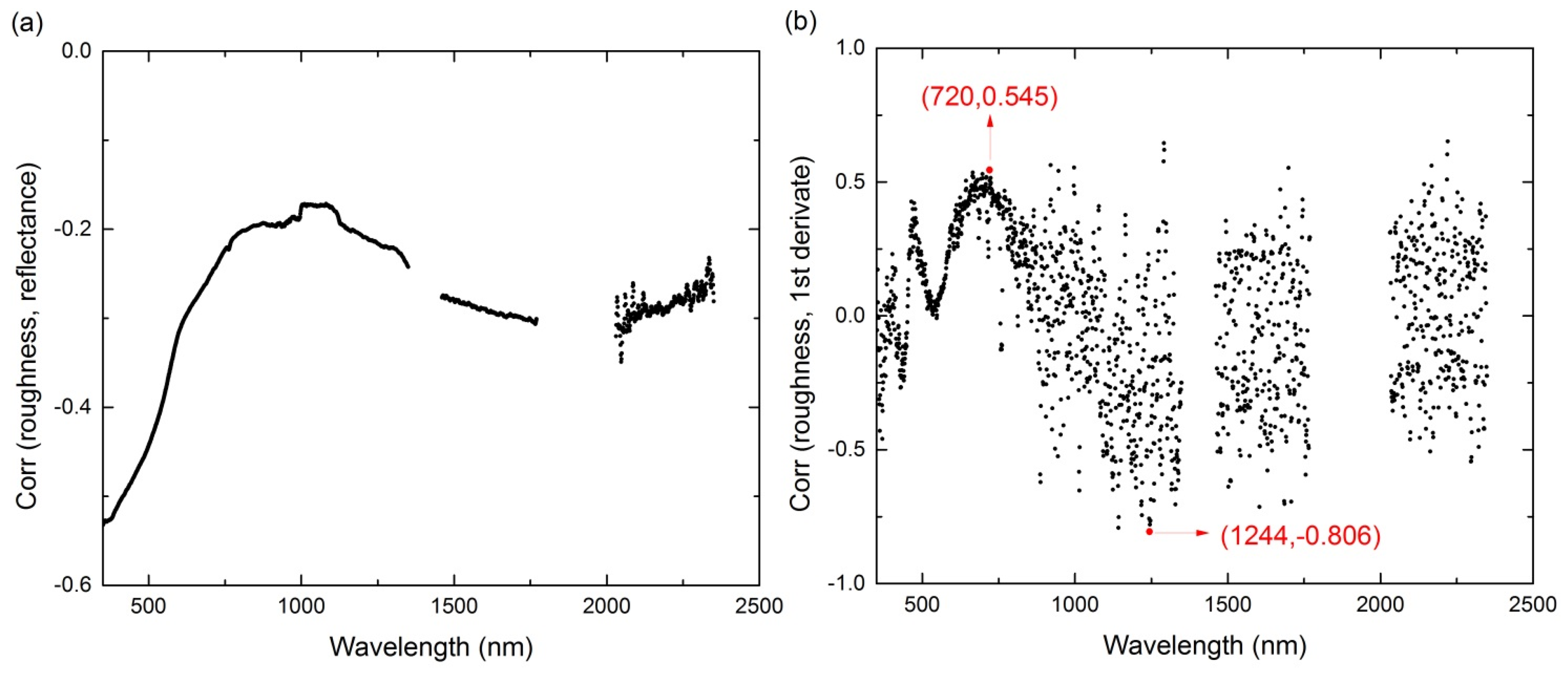
5. Interpretation and Discussion
5.1. Interpretation of Lava Spectral Curves

5.2. Comparison with Spaceborn Sensor Data
5.3. Effect of Weathering
5.3.1. Oxidation Index and Its Application to Landsat ETM+ Image
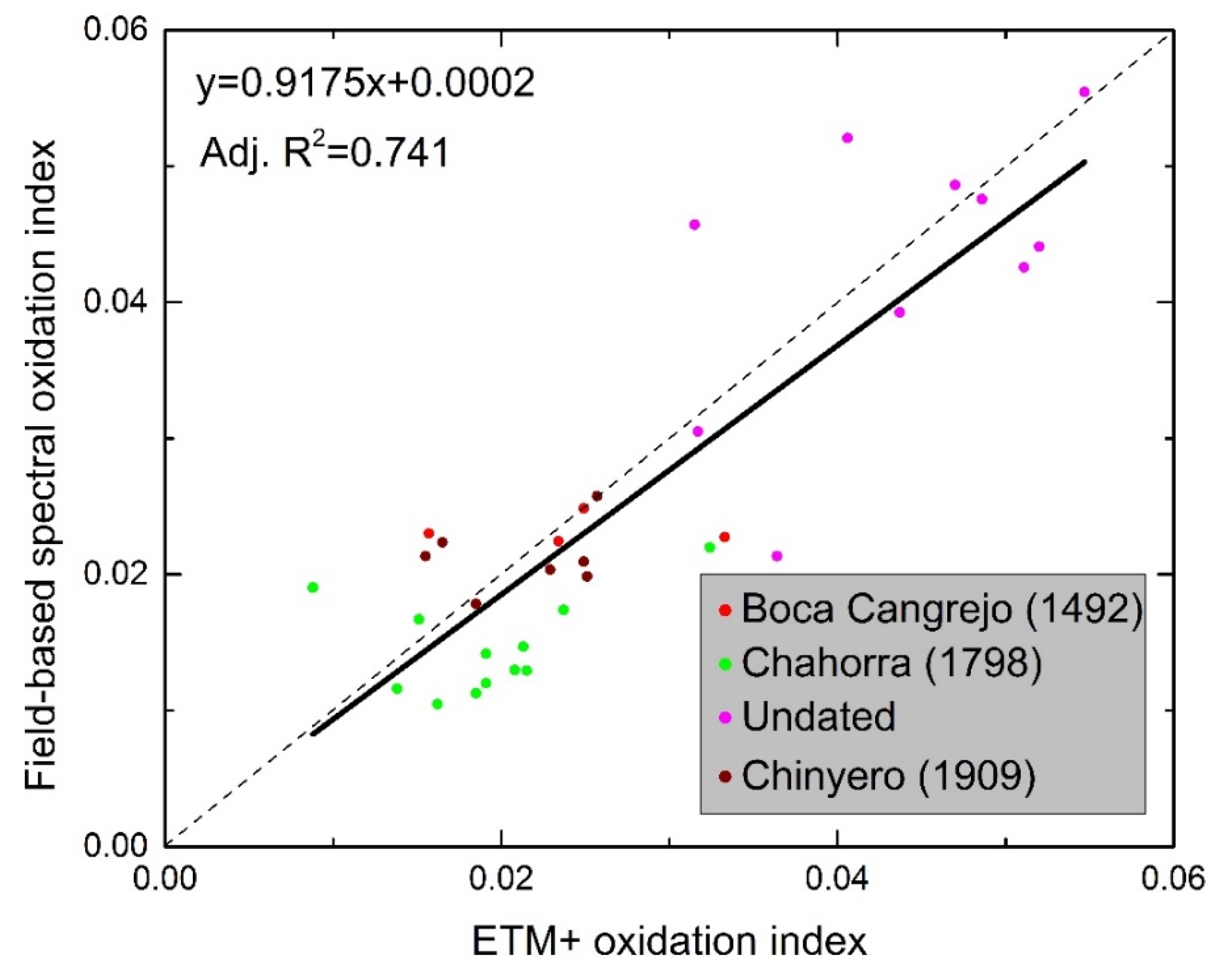
5.3.2. Lichen Index and Its Application to the Hyperion Image
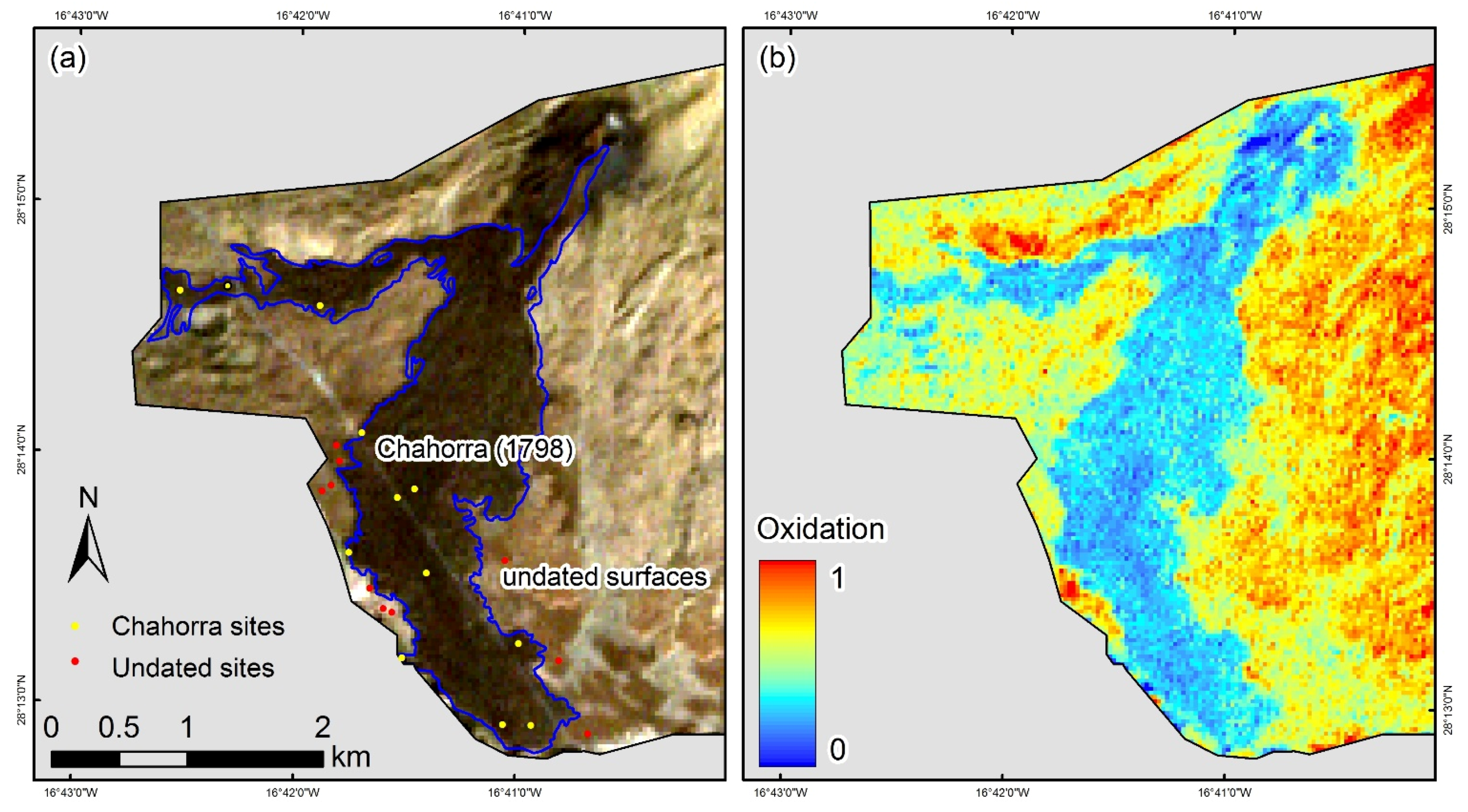
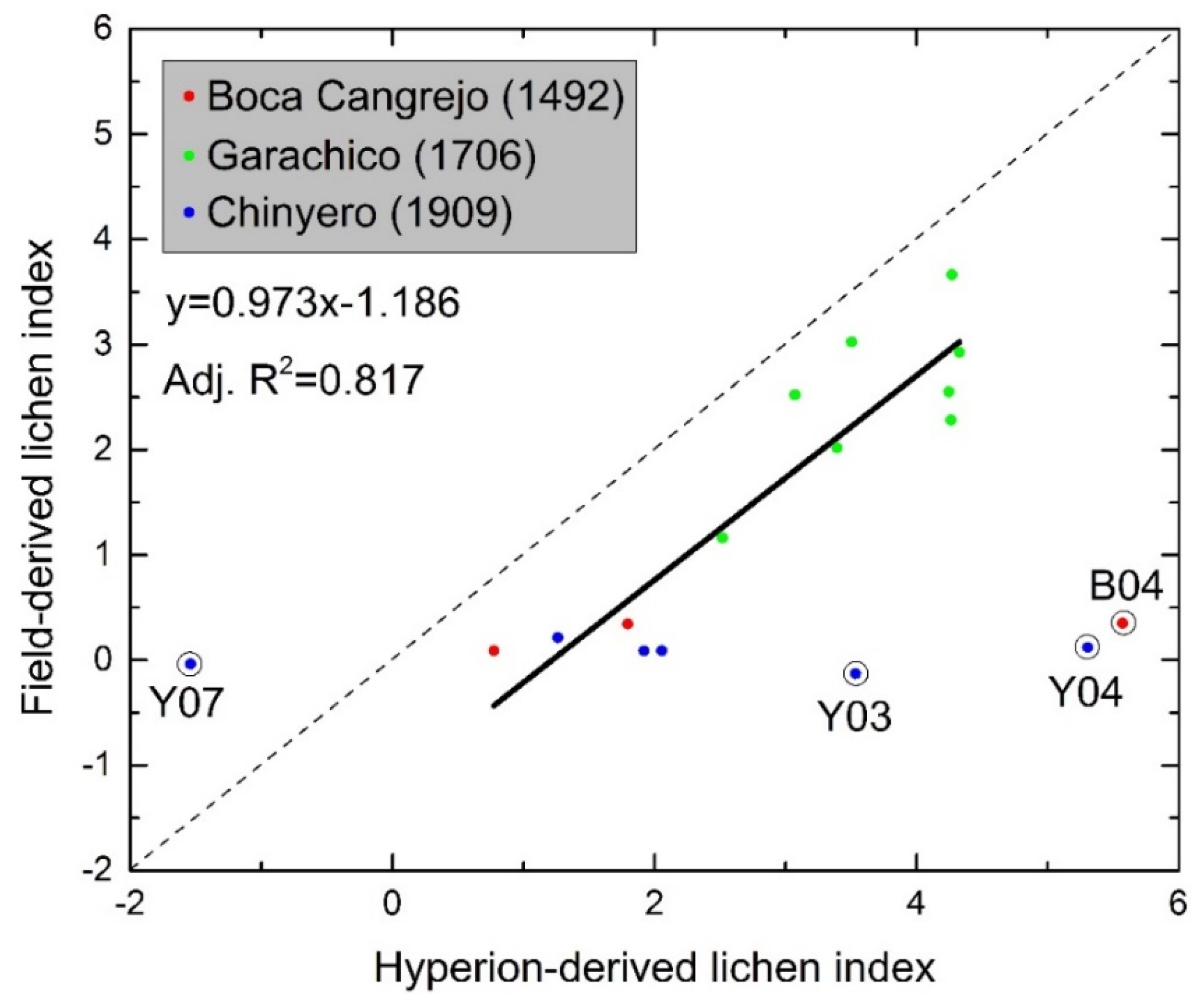

5.4. Effect of Surface Roughness
6. Conclusions
- Chemical weathering in the form of oxidation and biological weathering as a result of lichen growth can affect the spectra of lavas considerably.
- Bare lava surfaces with no lichen show low and flat reflectance spectra, increasing in the visible and decreasing in the infrared part of the spectrum. This trend tends to be more expressed for older lava flows which are affected by significant surface oxidation. Particularly, the slope of the reflectance curve from the blue to the red range of the spectrum increases as oxidation becomes stronger, a spectral feature which is useful for defining an oxidation index that is able to relatively quantify the oxidation degree of lava surfaces.
- Lavas affected by lichens have spectral features that are similar to those of lichens. Wavelengths (1660 nm and 1725 nm) sensitive to lichen colonization have been identified and used to develop an NDVI-like lichen index. A strong linear relationship between this index and lichen coverage recorded in the field has been observed, which might be used for spatial-temporal analysis of lichen cover development.
- Surface roughness has a limited but significant influence on the spectra of lavas. Smoother lava surfaces have higher reflectance than rough ones, especially at short wavelengths, and their maximum reflectance value is found at shorter wavelengths. Roughness is therefore positively correlated with the first-order derivative of reflectance at 720 nm. It requires further exploration to find out whether the visible and NIR bands of multispectral and hyperspectral images allow discriminating pāhoehoe from ʻaʻā lava surfaces.
Acknowledgments
Author Contributions
Conflicts of Interest
Appendix
Descriptions of Sites Measured on Tenerife
| Site | Acquisition | Elevation (m) | Roughness (m) | Surface Description | Lichen (%) | Oxidation (%) |
|---|---|---|---|---|---|---|
| B01P | 2013 | 1473 | 27.83 | Pāhoehoe lava, unvegetated, unnoticeable lichen, grey color with yellow dust, very smooth surface | 0 | 10* |
| B02 | 2013 | 1235 | 27.8 | ʻAʻā lava, scattered pine trees, white lichen (5%), reddish alteration, platy blocks Ø = 0.1–1 m | 5 * | 25 * |
| B03 | 2014 | 1350 | 26.69 | ʻAʻā lava, unvegetated, reddish alteration, blocks Ø = 0.1–0.5 m | 0 | 23.6 * |
| B04 | 2014 | 1344 | 26.85 | ʻAʻā lava, unvegetated, reddish alteration, platy blocks Ø = 0.5–1.5 m | 0 | 27.2 * |
| C01 | 2013 | 2061 | 25.26 | ʻAʻā lava, unvegetated, fresh, dark with weathering layer of brown-orange color, variable sizes | 0 | 20 * |
| C02 | 2013 | 2077 | 26.25 | ʻAʻā lava, unvegetated, 30 m away from the caldera wall, fresh with weak weathering, blocks Ø = 0.05–0.5 m | 0 | 20 * |
| C03P | 2013 | 2102 | 28.98 | Pāhoehoe lava, unvegetated, fresh, dark with little weathering, very smooth surface with broken pieces | 0 | 10 * |
| C04 | 2013 | 2102 | 26.91 | ʻAʻā lava, unvegetated, fresh, dark with orange alteration, blocks Ø = 0.05–0.5 m | 0 | 20 * |
| C05 | 2014 | 2066 | 26.93 | ʻAʻā lava, unvegetated, fresh, dark with limited weathering, blocks Ø = 0.5 m | 0 | 35 |
| C06 | 2014 | 2104 | 24.97 | ʻAʻā lava, unvegetated, fresh, dark with limited weathering, blocks Ø = 0.1–0.5 m | 0 | 28.8 |
| C07 | 2014 | 2054 | 23.85 | ʻAʻā lava, unvegetated, fresh, dark with weathering, blocks Ø = 0.1–0.5 m | 0 | 47 |
| C08 | 2014 | 2106 | 23.79 | ʻAʻā lava, unvegetated, fresh, dark with limited weathering, blocks Ø = 0.1–0.5 m | 0 | 12 |
| C09 | 2014 | 2040 | 25.65 | ʻAʻā lava, unvegetated, fresh, dark with limited weathering, blocks Ø = 0.1–0.5 m | 0 | 15 |
| C10 | 2014 | 2032 | 25.29 | ʻAʻā lava, unvegetated, fresh, dark with weathering, blocks Ø = 0.1–0.5 m | 0 | 22.2 |
| C11 | 2014 | 2016 | 26.24 | ʻAʻā lava, unvegetated, fresh, dark with weathering, blocks Ø = 0.02–0.5 m | 0 | 21.4 |
| C12 | 2014 | 1062 | 24.55 | ʻAʻā lava, unvegetated, fresh, dark with weathering, blocks Ø = 0.5–1 m | 0 | 25.6 |
| F01 | 2013 | 2294 | 28* | ʻAʻā lava, unvegetated, fresh, dark with limited weathering, blocks Ø = 0.1–0.3 m | 0 | 10 * |
| F02 | 2013 | 2191 | 28* | ʻAʻā lava, unvegetated, fresh, dark with weathering, blocks Ø = 0.1–0.3 m | 0 | 20 * |
| F03T | 2013 | 2198 | 29* | Lapilli, scattered bushes, dark, Ø = 0.003–0.008 m | 0 | 0 |
| F04T | 2013 | 2194 | 29* | Lapilli, scattered bushes, dark, Ø = 0.002–0.003 m, scattered bombs Ø = 0.1 m | 0 | 0 |
| G01T | 2013 | 1304 | 29* | Lapilli, dark, Ø = 0.005–0.01 m, scattered bombs | 0 | 0 |
| G02 | 2013 | 1207 | 26* | ʻAʻā lava, lichen, small shrubs of 0.2–0.3 m height, filled with lapilli Ø = 0.002–0.008 m | 20 * | 0 |
| G03 | 2013 | 1084 | 25.55 | ʻAʻā lava, much lichen, scattered pine trees, blocks Ø = 0.002–0.5 m | 40 * | 0 |
| G04 | 2014 | 1036 | 25.27 | ʻAʻā lava, much lichen, ferns of 0.15–0.3 m height and shrubs of 0.5–0.75 m, blocks Ø = 0.2–0.5 m | 54.8 | 11.4 |
| G05 | 2014 | 1114 | 27.87 | ʻAʻā lava, much lichen, few ferns, blocks Ø = 0.1–0.8 m | 34.6 | 0 |
| G06 | 2014 | 1068 | 27.11 | ʻAʻā lava, much lichen, no vegetation, blocks Ø = 0.1–0.8 m | 52.4 | 0 |
| G07 | 2014 | 1101 | 27.17 | ʻAʻā lava, much lichen, scattered green ferns and brown bushes, blocks Ø = 0.1–0.8 m | 50 | 0 |
| G08 | 2014 | 1118 | 27.32 | ʻAʻā lava, much lichen, scattered green ferns and brown bushes, blocks Ø = 0.1–0.5 m | 38.8 | 0 |
| G09 | 2014 | 1150 | 26.05 | ʻAʻā lava, much lichen, scattered green ferns and brown bushes, blocks Ø = 0.1–0.5 m | 25.8 | 0 |
| U01P | 2013 | 2071 | 29.23 | Pāhoehoe lava, scattered dry bushes, hummocky surface, brown alteration | 0 | 70 * |
| U02 | 2013 | 2087 | 26.85 | ʻAʻā lava, no vegetation, dark grey with orange alteration, blocks Ø = 0.05–0.4 m | 0 | 25 * |
| U03 | 2014 | 2082 | 28.53 | ʻAʻā lava, scattered plants, brown alteration, blocks Ø = 0.05–0.3 m | 0 | 17.6 |
| U04 | 2014 | 2078 | 28.13 | ʻAʻā lava, brown bushes, brown alteration, blocks Ø = 0.05–0.3 m | 0 | 61.1 |
| U05 | 2014 | 2081 | 27.87 | ʻAʻā lava, no vegetation, brown alteration, blocks Ø = 0.05–0.3 m | 0 | 59.6 |
| U06P | 2014 | 2072 | 28.36 | Pāhoehoe lava, green bushes, hummocky surface, brown alteration | 0 | 70 * |
| U07P | 2014 | 2068 | 28.36 * | Pāhoehoe lava, green bushes, hummocky surface, brown alteration | 0 | 70 * |
| U08 | 2014 | 2074 | 27 | ʻAʻā lava, no vegetation, brown alteration, blocks Ø = 0.05–1 m | 0 | 62 |
| U09 | 2014 | 2054 | 27.92 | ʻAʻā lava, no vegetation, brown alteration, blocks Ø = 0.05–1 m | 0 | 56.2 |
| U10 | 2014 | 2040 | 27.2 | ʻAʻā lava, no vegetation, yellow and brown alteration, blocks Ø = 0.05–1 m | 0 | 72.2 |
| Y01 | 2013 | 1279 | 25.1 | ʻAʻā lava, unnoticeable moss, flat slab with yellow alteration | 0 | 10 * |
| Y02 | 2013 | 1271 | 25.1 | ʻAʻā lava, little lichen and moss, yellow alteration on large blocks Ø = 0.5 m | 5 * | 15 * |
| Y03 | 2013 | 1460 | 24.18 | ʻAʻā lava, no vegetation, dark with mixed colors with much weathering, blocks Ø = 0.02–1 m | 0 | 42.4 |
| Y04 | 2014 | 1419 | 26.35 | ʻAʻā lava, no vegetation, grey dark, alteration of mixed colors, blocks Ø = 0.03-0.2 m, maximum size = 3 m | 2.9 | 41.8 |
| Y05 | 2014 | 1299 | 25.84 | ʻAʻā lava, no vegetation, grey dark, alteration of mixed colors, blocks Ø = 0.2–1 m | 1.8 | 39.6 |
| Y06 | 2014 | 1227 | 26.59 | ʻAʻā lava, no vegetation, grey dark, brown alteration, blocks Ø = 0.2–0.8 m | 6.6 | 29.4 |
| Y07 | 2014 | 1449 | 27.14 | ʻAʻā lava, no vegetation, alteration of mixed colors, blocks Ø = 0.1–1 m | 6 | 44.4 |
Regression Models for the Oxidation Indices
| Index | Scale | Model | ref1 (400); ref2 (800) | ref1 (450–520); ref2 (630–690) | ref1 (485); ref2 (660) | ref1 (450–495); ref2 (620–750) | ref1 (475); ref2 (685) |
|---|---|---|---|---|---|---|---|
| Subtraction | site | a | 9.104 | 13.151 | 12.940 | 12.149 | 12.089 |
| b | −0.008 | 0.012 | 0.011 | 0.003 | 0.006 | ||
| adj. R2 | 0.740 | 0.759 | 0.759 | 0.760 | 0.768 | ||
| spot | a | 9.124 | 13.422 | 13.239 | 12.374 | 12.32 | |
| b | 0.003 | 0.023 | 0.021 | 0.013 | 0.016 | ||
| adj. R2 | 0.563 | 0.543 | 0.543 | 0.554 | 0.551 | ||
| Ratio | site | a | 0.304 | 0.731 | 0.712 | 0.622 | 0.638 |
| b | −0.334 | −0.842 | −0.825 | −0.726 | −0.749 | ||
| adj. R2 | 0.485 | 0.590 | 0.592 | 0.565 | 0.590 | ||
| spot | a | 0.362 | 0.791 | 0.768 | 0.690 | 0.691 | |
| b | −0.474 | −0.948 | −0.925 | −0.853 | −0.85 | ||
| adj. R2 | 0.551 | 0.527 | 0.527 | 0.541 | 0.539 | ||
| Normalized difference | site | a | 1.511 | 2.558 | 2.528 | 2.303 | 2.368 |
| b | −0.212 | −0.251 | −0.257 | −0.252 | −0.265 | ||
| adj. R2 | 0.459 | 0.584 | 0.585 | 0.552 | 0.580 | ||
| spot | a | 2.074 | 2.926 | 2.885 | 2.761 | 2.753 | |
| b | −0.427 | −0.342 | −0.348 | −0.378 | −0.372 | ||
| adj. R2 | 0.538 | 0.526 | 0.527 | 0.540 | 0.537 |
Regression Models for the Lichen Indices
| Index | Scale | ref1 (680); ref2 (1320) | ref1 (1725); ref2 (1660) | ref1 (2300); ref2 (2230) |
|---|---|---|---|---|
| Subtraction | site | y = 4.112x − 0.030; adj. R2 = 0.928 | y = 39.818x + 0.029; adj. R2 = 0.917 | y = 21.716x + 0.0001; adj. R2 = 0.924 |
| spot | y = 3.637x − 0.007; adj. R2 = 0.615 | y = 35.826x + 0.038; adj. R2 = 0.762 | y = 19.902x + 0.017; adj. R2 = 0.727 | |
| Ratio | site | y = 0.232x2 − 0.490x + 0.266; adj. R2 = 0.877 | y = 7.256x − 7.249; adj. R2 = 0.942 | y = 2.568x − 2.586; adj. R2 = 0.849 |
| spot | y = 0.024x2 + 0.211x − 0.253; adj. R2 = 0.576 | y = 6.747x − 6.738; adj. R2 = 0.785 | y = 2.584x − 2.590; adj. R2 = 0.781 | |
| Normalized difference | site | y = 2.672x2 − 0.064x − 0.014; adj. R2 = 0.859 | y = 14.983x + 0.006; adj. R2 = 0.942 | y = 5.553x − 0.021; adj. R2 = 0.838 |
| spot | y = 2.498x2 − 0.026x − 0.010; adj. R2 = 0.602 | y = 14.014x + 0.008; adj. R2 = 0.784 | y = 5.690x − 0.010; adj. R2 = 0.778 |
References
- U.S. Geological Survey. Types of Volcano Hazards. Available online: http://volcanoes.usgs.gov/hazards/index.php (accessed on 30 October 2015).
- Harris, A.J.L. Basaltic lava flow hazard. In Volcanic Hazards, Risks and Disaters; Papale, P., Ed.; Elsevier: Amsterdam, Netherlands, 2014; pp. 27–46. [Google Scholar]
- Ernst, G.G.J.; Kervyn, M.; Teeuw, R.M. Advances in the remote sensing of volcanic activity and hazards, with special consideration to applications in developing countries. Int. J. Remote Sens. 2008, 29, 6687–6723. [Google Scholar] [CrossRef]
- Kervyn, M.; Kervyn, F.; Goossens, R.; Rowland, S.K.; Ernst, G.G.J. Mapping volcanic terrain using high-resolution and 3D satellite remote sensing. Geol. Soc. Lond. Spec. Publ. 2007, 283, 5–30. [Google Scholar] [CrossRef]
- Lombardo, V.; Buongiorno, M.F. Lava flow thermal analysis using three infrared bands of remote-sensing imagery: A study case from Mount Etna 2001 eruption. Remote Sens. Environ. 2006, 101, 141–149. [Google Scholar] [CrossRef]
- Webley, P.W.; Lopez, T.M.; Ekstrand, A.L.; Dean, K.G.; Rinkleff, P.; Dehn, J.; Cahill, C.F.; Wessels, R.L.; Bailey, J.E.; Izbekov, P.; et al. Remote observations of eruptive clouds and surface thermal activity during the 2009 eruption of Redoubt volcano. J. Volcanol. Geotherm. Res. 2013, 259, 185–200. [Google Scholar] [CrossRef]
- Harris, A. Thermal Remote Sensing of Active Volcanoes: A User’s Manual; Cambridge University Press: Camridge, UK, 2013. [Google Scholar]
- Dietterich, H.R.; Poland, M.P.; Schmidt, D.A.; Cashman, K.V.; Sherrod, D.R.; Espinosa, A.T. Tracking lava flow emplacement on the east rift zone of Klauea, Hawaii, with synthetic aperture radar coherence. Geochem. Geophys. Geosyst. 2012, 13, 1–17. [Google Scholar] [CrossRef]
- Pieri, D.; Abrams, M. ASTER observations of thermal anomalies preceding the April 2003 eruption of Chikurachki volcano, Kurile Islands, Russia. Remote Sens. Environ. 2005, 99, 84–94. [Google Scholar] [CrossRef]
- Blackett, M. Early Analysis of Landsat-8 thermal infrared sensor imagery of volcanic activity. Remote Sens. 2014, 6, 2282–2295. [Google Scholar] [CrossRef]
- Lu, Z.; Rykhus, R.; Masterlark, T.; Dean, K.G. Mapping recent lava flows at Westdahl Volcano, Alaska, using radar and optical satellite imagery. Remote Sens. Environ. 2004, 91, 345–353. [Google Scholar] [CrossRef]
- Patrick, M.; Dehn, J.; Papp, K.; Lu, Z.; Dean, K.; Moxey, L.; Izbekov, P.; Guritz, R. The 1997 eruption of Okmok Volcano, Alaska: A synthesis of remotely sensed imagery. J. Volcanol. Geotherm. Res. 2003, 127, 87–105. [Google Scholar] [CrossRef]
- Rowland, S. Slopes, lava fow volumes, and vent distrubtions on Volcan Fernandina, Galapagos Islands. J. Geophys. Res. 1996, 101, 27657–27672. [Google Scholar] [CrossRef]
- Kahle, A.B.; Gillespie, A.R.; Abbott, E.A.; Abrams, M.J.; Walker, R.E.; Hoover, G.; Lockwood, J.P. Relative dating of Hawaiian lava flows using multispectral thermal infrared images: A new tool for geologic mapping of young volcanic terranes. J. Afr. Earth Sci. 1988, 93, 15239–15251. [Google Scholar] [CrossRef]
- Abrams, M.; Abbott, E.; Kahle, A. Combined use of visible, reflected infrared, and thermal infrared images for mapping Hawaiian lava flows. J. Geophys. Res. 1991, 96, 475–484. [Google Scholar] [CrossRef]
- Tarquini, S.; Favalli, M.; Mazzarini, F.; Isola, I.; Fornaciai, A. Morphometric analysis of lava flow units: Case study over LIDAR-derived topography at Mount Etna, Italy. J. Volcanol. Geotherm. Res. 2012, 235–236, 11–22. [Google Scholar] [CrossRef]
- Ramsey, M.S.; Fink, J.H. Estimating silicic lava vesicularity with thermal remote sensing: A new technique for volcanic mapping and monitoring. Bull. Volcanol. 1999, 61, 32–39. [Google Scholar] [CrossRef]
- Gaddis, L.R.; Mouginis-Mark, P.J.; Hayashi, J.N. Lava flow surface textures—SIR-B radar image texture, field observations, and terrain measurements. 1990, 56, 211–224. [Google Scholar]
- Campbell, B.A.; Shepard, M.K. Lava flow surface roughness and depolarized radar scattering. J. Geophys. Res. 1996, 101, 18941. [Google Scholar] [CrossRef]
- Li, L.; Canters, F.; Solana, C.; Ma, W.; Chen, L.; Kervyn, M. Discriminating lava flows of different age within Nyamuragira’s volcanic field using spectral mixture analysis. Int. J. Appl. Earth Obs. Geoinf. 2015, 40, 1–10. [Google Scholar] [CrossRef]
- Spinetti, C.; Mazzarini, F.; Casacchia, R.; Colini, L.; Neri, M.; Behncke, B.; Salvatori, R.; Buongiorno, M.F.; Pareschi, M.T. Spectral properties of volcanic materials from hyperspectral field and satellite data compared with LiDAR data at Mt. Etna. Int. J. Appl. Earth Obs. Geoinf. 2009, 11, 142–155. [Google Scholar] [CrossRef]
- Head, E.M.; Maclean, A.L.; Carn, S.A. Mapping lava flows from Nyamuragira volcano (1967–2011) with satellite data and automated classification methods. Geomat. Nat. Hazards Risk 2013, 4, 119–144. [Google Scholar] [CrossRef]
- Sgavetti, M.; Pompilio, L.; Meli, S. Reflectance spectroscopy (0.3–2.5 μm) at various scales for bulk-rock identification. Geosphere 2006, 2, 142–160. [Google Scholar] [CrossRef]
- Amici, S.; Piscini, A.; Neri, M. Reflectance spectra measurements of Mt. Etna: A comparison with multispectral/hyperspectral satellite. Adv. Remote Sens. 2014, 3, 235–245. [Google Scholar] [CrossRef]
- Stretch, R.C.; Viles, H.A. The nature and rate of weathering by lichens on lava flows on Lanzarote. Geomorphology 2002, 47, 87–94. [Google Scholar] [CrossRef]
- Rothery, D.A.; Lefevre, R.H. The causes of age dependent changes in the spectral response of lavas, Craters of the Moon, Idaho, U.S.A. Int. J. Remote Sens. 1985, 6, 1483–1489. [Google Scholar] [CrossRef]
- Abbott, E.A.; Gillespie, A.R.; Kahle, A.B. Thermal-infrared imaging of weathering and alteration changes on the surfaces of basalt flows, Hawai’i, USA. Int. J. Remote Sens. 2013, 34, 1–24. [Google Scholar] [CrossRef]
- Benedetti, M. Chemical weathering of basaltic lava flows undergoing extreme climatic conditions: The water geochemistry record. Chem. Geol. 2003, 201, 1–17. [Google Scholar] [CrossRef]
- Di Figlia, M.G.; Bellanca, A.; Neri, R.; Stefansson, A. Chemical weathering of volcanic rocks at the island of Pantelleria, Italy: Information from soil profile and soil solution investigations. Chem. Geol. 2007, 246, 1–18. [Google Scholar] [CrossRef]
- Yamasaki, S.; Sawada, R.; Ozawa, A.; Tagami, T.; Watanabe, Y.; Takahashi, E. Unspiked K-Ar dating of Koolau lavas, Hawaii: Evaluation of the influence of weathering/alteration on age determinations. Chem. Geol. 2011, 287, 41–53. [Google Scholar] [CrossRef]
- Ager, C.M.; Milton, N.M. Spectral reflectance of lichens and their effects on the reflectance of rock substrates. Geophysics 1987, 52, 898–906. [Google Scholar] [CrossRef]
- Rollin, E.; Milton, E.; Roche, P. The influence of weathering and lichen cover on the reflectance spectra of granitic rocks. Remote Sens. Environ. 1994, 50, 194–199. [Google Scholar] [CrossRef]
- Rees, W.G.; Tutubalina, O.V.; Golubeva, E.I. Reflectance spectra of subarctic lichens between 400 and 2400 nm. Remote Sens. Environ. 2004, 90, 281–292. [Google Scholar] [CrossRef]
- Pórtoles, F.J.; Torres, L.; Ribalaygua, J.; Monjo, R. Monthly rainfall maps for Tenerife (Canary Islands): Comparing interpolation methods under local climate conditions. In Proceedings of 11th Annual Meeting of the European Meteorological Society (EMS) and the 10th European Conference on Applications of Meteorology (ECAM), Berlin, Germany, 12–16 September 2011.
- Del Arco Aguilar, M.-J.; González-González, R.; Garzón-Machado, V.; Pizarro-Hernández, B. Actual and potential natural vegetation on the Canary Islands and its conservation status. Biodivers. Conserv. 2010, 19, 3089–3140. [Google Scholar] [CrossRef]
- Solana, M.C. Development of unconfined historic lava flow fields in Tenerife: Implications for the mitigation of risk from a future eruption. Bull. Volcanol. 2012, 74, 2397–2413. [Google Scholar] [CrossRef]
- Cabrera Lagunilla, P.; Hernández Pacheco, A. Las erupciones históricas de Tenerife (Canarias) en sus aspectos vulcanológicos, petrológico y geoquímico. Rev. Mater. Procesos Geol. 1987, 5, 143–182. (In Spanish) [Google Scholar]
- Tenerife Island Council Digital Atlas of Tenerife. Available online: http://atlastenerife.es/portalweb/en/download-area/informacion-general (accessed on 27 November 2014).
- Analytical Spectral Devices. Field Spec Pro User’s Guide; Analytical Spectral Devices: Boulder, CO, USA, 2002. [Google Scholar]
- Mazzarini, F.; Pareschi, M.T.; Favalli, M.; Isola, I.; Tarquini, S. Lava flow identification and aging by means of LiDAR intensity: The Mt. Etna case. J. Geophys. Res. 2007, 112. [Google Scholar] [CrossRef]
- Chen, J.; Blume, H.-P.; Beyer, L. Weathering of rocks induced by lichen colonization—A review. Catena 2000, 39, 121–146. [Google Scholar] [CrossRef]
- Aghamiri, R.; Schwartzman, D.W. Weathering rates of bedrock by lichens: A mini watershed study. Chem. Geol. 2002, 188, 249–259. [Google Scholar] [CrossRef]
- Morris, A.R.; Anderson, F.S.; Mouginis-mark, P.J.; Haldemann, A.F.C.; Brooks, B.A.; Foster, J. Roughness of Hawaiian volcanic terrains. J. Geophys. Res. 2008, 113, 1–20. [Google Scholar] [CrossRef]
- McCarroll, D. The schmidt hammer, weathering and rock surface roughness. Earth Surf. Process. Landf. 1991, 16, 477–480. [Google Scholar] [CrossRef]
- Medapati, R.S.; Kreidl, O.P.; MacLaughlin, M.; Hudyma, N.; Harris, A. Quantifying surface roughness of weathered rock—Examples from granite and limestone. In Geo-Congress 2013; Meehan, C., Pradel, D., Pando, M.A., Labuz, J.F., Eds.; American Society of Civil Engineers: San Diego, CA, USA, 2013; pp. 12–128. [Google Scholar]
- Thurmond, A.K.; Abdelsalam, M.G.; Thurmond, J.B. Optical-Radar-DEM remote sensing data integration for geological mapping in the Afar Depression, Ethiopia. J. Afr. Earth Sci. 2006, 44, 119–134. [Google Scholar] [CrossRef]
- Saleh, A. Soil roughness measurement-chain method. J. Soil Water Conserv. 1993, 48, 527–529. [Google Scholar]
- Karami, M.; Rangzan, K.; Saberi, A. Using GIS servers and interactive maps in spectral data sharing and administration: Case study of Ahvaz Spectral Geodatabase Platform (ASGP). Comput. Geosci. 2013, 60, 23–33. [Google Scholar] [CrossRef]
- Rolfson, D. Collection of endmembers and their separability for spectral unmixing in rangeland applications. Master Thesis, University of Lethbridge, Lethbridge, AL, Canada, 2010. [Google Scholar]
- Roberts, P.; Hueni, A.; Kuekenbrink, D. SPECCHIO User Guide; SPECCHIO: Zurich, Switzerland, 2014. [Google Scholar]
- NASA Landsat 7 Science Data Users Handbook. Available online: http://landsathandbook.gsfc.nasa.gov/pdfs/Landsat7_Handbook.pdf (accessed on 30 April 2015).
- Griffin, M.K.; May-Hsu, S.; Burke, H.K.; Orloff, S.M.; Upham, C.A. Examples of EO-1 Hyperion data analysis. Lincoln Lab. J. 2005, 15, 271–298. [Google Scholar]
- IDE Canarias Mapa Topográfico 1:5.000 Año 2009. Available online: http://www.idecanarias.es/listado_servicios/mapa-topografico-5000-a%C3%B1o-2009 (accessed on 1 December 2013).
- Richter, R.; Kellenberger, T.; Kaufmann, H. Comparison of topographic correction methods. Remote Sens. 2009, 1, 184–196. [Google Scholar] [CrossRef] [Green Version]
- Teillet, P.M.; Guindon, B.; Goodenough, D.G. On the slope-aspect correction of multispectral scanner data. Can. J. Remote Sens. 1982, 8, 84–106. [Google Scholar] [CrossRef]
- Drury, S. Digital image processing. In Image Interpretation in Geology; Nelson Thornes: Cheltenham, UK, 2001; p. 145. [Google Scholar]
- Pinty, B.; Lavergne, T.; Widlowski, J.L.; Gobron, N.; Verstraete, M.M. On the need to observe vegetation canopies in the near-infrared to estimate visible light absorption. Remote Sens. Environ. 2009, 113, 10–23. [Google Scholar] [CrossRef]
- Viña, A.; Gitelson, A.A.; Nguy-Robertson, A.L.; Peng, Y. Comparison of different vegetation indices for the remote assessment of green leaf area index of crops. Remote Sens. Environ. 2011, 115, 3468–3478. [Google Scholar] [CrossRef]
- Hunt, G.R. Spectral signatures of particulate minerals in the visible and near infrared. Geophysics 1977, 42, 501–513. [Google Scholar] [CrossRef] [Green Version]
- Clark, R.N.; Swayze, G.A.; Wise, R.; Livo, K.E.; Hoefen, T.M.; Kokaly, R.F.; Sutley, S.J. USGS Digital Spectral Library splib06a; U.S. Geological Survey: Reston, VA, USA, 2007. [Google Scholar]
- Rockwell, B.W. Spectral Variations in Rocks and Soils Containing Ferric Iron Hydroxide and(or) Sulfate Minerals as Seen by AVIRIS and Laboratory Spectroscopy; U.S. Geological Survey: Reston, VA, USA, 2004. [Google Scholar]
- Tayebi, M.H.; Tangestani, M.H.; Vincent, R.K. Sub-pixel mapping of iron-bearing minerals using ALI data and MTMF algorithm, Masahim volcano, SE Iran. Arab. J. Geosci. 2015, 8, 3799–3810. [Google Scholar] [CrossRef]
- Baldridge, A.M.; Hook, S.J.; Grove, C.I.; Rivera, G. The ASTER spectral library version 2.0. Remote Sens. Environ. 2009, 113, 711–715. [Google Scholar] [CrossRef]
- Drury, S. Electromagnetic radiation and materials. In Image Interpretation in Geology; Nelson Thornes: Cheltenham, UK, 2001; pp. 7–11. [Google Scholar]
- Kruse, F.A.; Boardman, J.W.; Huntington, J.F.; Mason, P.; Quigley, M.A. Evaluation and validation of EO-1 Hyperion for geologic mapping. In Proceedings of the IEEE International Geoscience and Remote Sensing Symposium (IGARSS 2002), Toronto, ON, Canada, 24–28 June 2002; pp. 593–595.
- Lockwood, J.P.; Lipman, P.W. Holocene eruptive history of Mauna Loa volcano. In Volcanism in Hawaii; U.S. Geological Survey: Reston, VA, USA; pp. 509–535.
- Minitti, M.E.; Mustard, J.F.; Rutherford, M.J. Effects of glass content and oxidation on the spectra of SNC-like basalts: Applications to Mars remote sensing. J. Geophys. Res. 2002, 107. [Google Scholar] [CrossRef]
© 2015 by the authors; licensee MDPI, Basel, Switzerland. This article is an open access article distributed under the terms and conditions of the Creative Commons by Attribution (CC-BY) license (http://creativecommons.org/licenses/by/4.0/).
Share and Cite
Li, L.; Solana, C.; Canters, F.; Chan, J.C.-W.; Kervyn, M. Impact of Environmental Factors on the Spectral Characteristics of Lava Surfaces: Field Spectrometry of Basaltic Lava Flows on Tenerife, Canary Islands, Spain. Remote Sens. 2015, 7, 16986-17012. https://doi.org/10.3390/rs71215864
Li L, Solana C, Canters F, Chan JC-W, Kervyn M. Impact of Environmental Factors on the Spectral Characteristics of Lava Surfaces: Field Spectrometry of Basaltic Lava Flows on Tenerife, Canary Islands, Spain. Remote Sensing. 2015; 7(12):16986-17012. https://doi.org/10.3390/rs71215864
Chicago/Turabian StyleLi, Long, Carmen Solana, Frank Canters, Jonathan C.-W. Chan, and Matthieu Kervyn. 2015. "Impact of Environmental Factors on the Spectral Characteristics of Lava Surfaces: Field Spectrometry of Basaltic Lava Flows on Tenerife, Canary Islands, Spain" Remote Sensing 7, no. 12: 16986-17012. https://doi.org/10.3390/rs71215864




